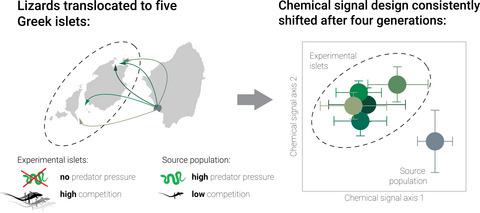当前位置:
X-MOL 学术
›
J. Anim. Ecol.
›
论文详情
Our official English website, www.x-mol.net, welcomes your feedback! (Note: you will need to create a separate account there.)
Rapid and repeated divergence of animal chemical signals in an island introduction experiment
Journal of Animal Ecology ( IF 4.8 ) Pub Date : 2020-04-20 , DOI: 10.1111/1365-2656.13205 Colin M Donihue 1, 2 , Anthony Herrel 2, 3, 4 , José Martín 5 , Johannes Foufopoulos 6 , Panayiotis Pafilis 7 , Simon Baeckens 3, 8
Journal of Animal Ecology ( IF 4.8 ) Pub Date : 2020-04-20 , DOI: 10.1111/1365-2656.13205 Colin M Donihue 1, 2 , Anthony Herrel 2, 3, 4 , José Martín 5 , Johannes Foufopoulos 6 , Panayiotis Pafilis 7 , Simon Baeckens 3, 8
Affiliation

|
Studies of animal communication have documented myriad rapid, context-dependent changes in visual and acoustic signal design. In contrast, relatively little is known about the capacity of vertebrate chemical signals to rapidly respond, either plastically or deterministically, to changes in context. Four years following an experimental introduction of lizards to replicate experimental islets, we aimed to determine if chemical signal design of the experimental populations differed from that of the source population. In 2014, we translocated Podarcis erhardii lizards from a large, predator-rich island to each of five replicate predator-free islets. Mean population densities increased fivefold over the following 4 years and bite scars suggest significantly more intraspecific fighting among these experimental populations. In 2018, we analysed the chemical signal design of males in each of the experimental populations and compared it to the chemical signals of the source population. We found that males consistently presented a significantly more complex chemical signal compared to the source population. Moreover, their chemical signals were marked by high proportions of octadecanoic acid, oleic acid and α-tocopherol, the three compounds that are known to be associated with lizard territoriality and mate choice. Our island introduction experiment thus suggests that the chemical signal design of animals can shift rapidly and predictably in novel ecological contexts.
中文翻译:

岛屿引入实验中动物化学信号的快速重复发散
动物交流的研究记录了视觉和听觉信号设计中无数快速的、依赖于上下文的变化。相比之下,关于脊椎动物化学信号对环境变化做出快速反应(塑性或确定性)的能力知之甚少。在实验引入蜥蜴来复制实验胰岛四年后,我们旨在确定实验种群的化学信号设计是否与源种群的化学信号设计不同。2014 年,我们将 Podarcis erhardii 蜥蜴从一个捕食丰富的大型岛屿转移到五个复制的无捕食者小岛中的每一个。在接下来的 4 年中,平均种群密度增加了五倍,咬痕表明这些实验种群之间的种内战斗明显增多。2018 年,我们分析了每个实验种群中雄性的化学信号设计,并将其与源种群的化学信号进行了比较。我们发现,与源种群相比,雄性始终呈现出明显更复杂的化学信号。此外,它们的化学信号以高比例的十八烷酸、油酸和α-生育酚为特征,这三种化合物已知与蜥蜴的领地性和配偶选择有关。因此,我们的岛屿引入实验表明,动物的化学信号设计可以在新的生态环境中快速且可预测地发生变化。我们发现,与源种群相比,雄性始终呈现出明显更复杂的化学信号。此外,它们的化学信号以高比例的十八烷酸、油酸和α-生育酚为特征,这三种化合物已知与蜥蜴的领地性和配偶选择有关。因此,我们的岛屿引入实验表明,动物的化学信号设计可以在新的生态环境中快速且可预测地发生变化。我们发现,与源种群相比,雄性始终呈现出明显更复杂的化学信号。此外,它们的化学信号以高比例的十八烷酸、油酸和α-生育酚为特征,这三种化合物已知与蜥蜴的领地性和配偶选择有关。因此,我们的岛屿引入实验表明,动物的化学信号设计可以在新的生态环境中快速且可预测地发生变化。
更新日期:2020-04-20
中文翻译:

岛屿引入实验中动物化学信号的快速重复发散
动物交流的研究记录了视觉和听觉信号设计中无数快速的、依赖于上下文的变化。相比之下,关于脊椎动物化学信号对环境变化做出快速反应(塑性或确定性)的能力知之甚少。在实验引入蜥蜴来复制实验胰岛四年后,我们旨在确定实验种群的化学信号设计是否与源种群的化学信号设计不同。2014 年,我们将 Podarcis erhardii 蜥蜴从一个捕食丰富的大型岛屿转移到五个复制的无捕食者小岛中的每一个。在接下来的 4 年中,平均种群密度增加了五倍,咬痕表明这些实验种群之间的种内战斗明显增多。2018 年,我们分析了每个实验种群中雄性的化学信号设计,并将其与源种群的化学信号进行了比较。我们发现,与源种群相比,雄性始终呈现出明显更复杂的化学信号。此外,它们的化学信号以高比例的十八烷酸、油酸和α-生育酚为特征,这三种化合物已知与蜥蜴的领地性和配偶选择有关。因此,我们的岛屿引入实验表明,动物的化学信号设计可以在新的生态环境中快速且可预测地发生变化。我们发现,与源种群相比,雄性始终呈现出明显更复杂的化学信号。此外,它们的化学信号以高比例的十八烷酸、油酸和α-生育酚为特征,这三种化合物已知与蜥蜴的领地性和配偶选择有关。因此,我们的岛屿引入实验表明,动物的化学信号设计可以在新的生态环境中快速且可预测地发生变化。我们发现,与源种群相比,雄性始终呈现出明显更复杂的化学信号。此外,它们的化学信号以高比例的十八烷酸、油酸和α-生育酚为特征,这三种化合物已知与蜥蜴的领地性和配偶选择有关。因此,我们的岛屿引入实验表明,动物的化学信号设计可以在新的生态环境中快速且可预测地发生变化。



























 京公网安备 11010802027423号
京公网安备 11010802027423号